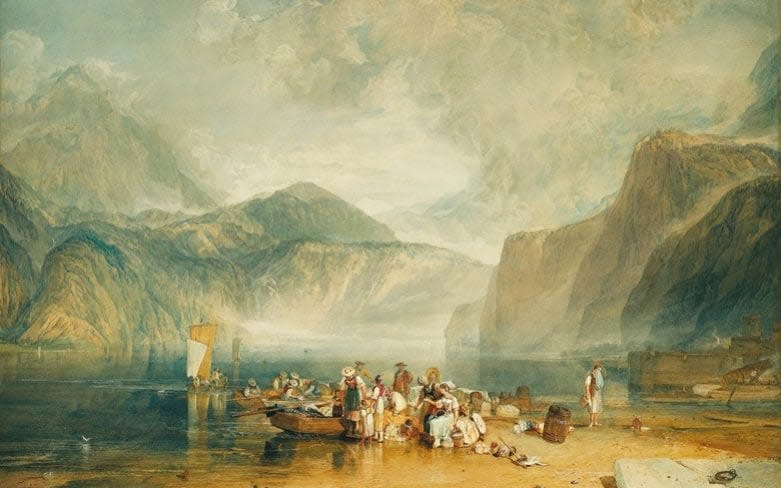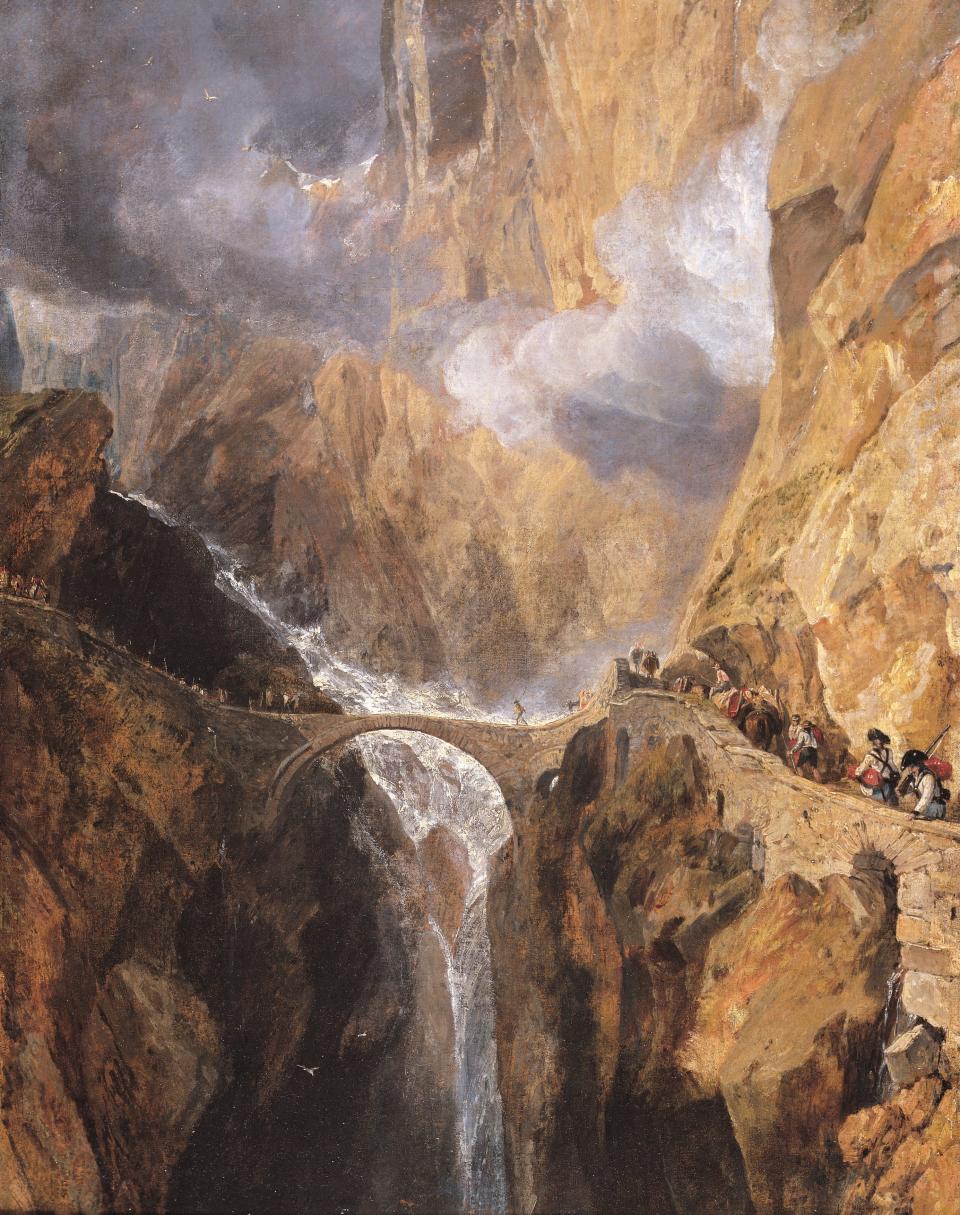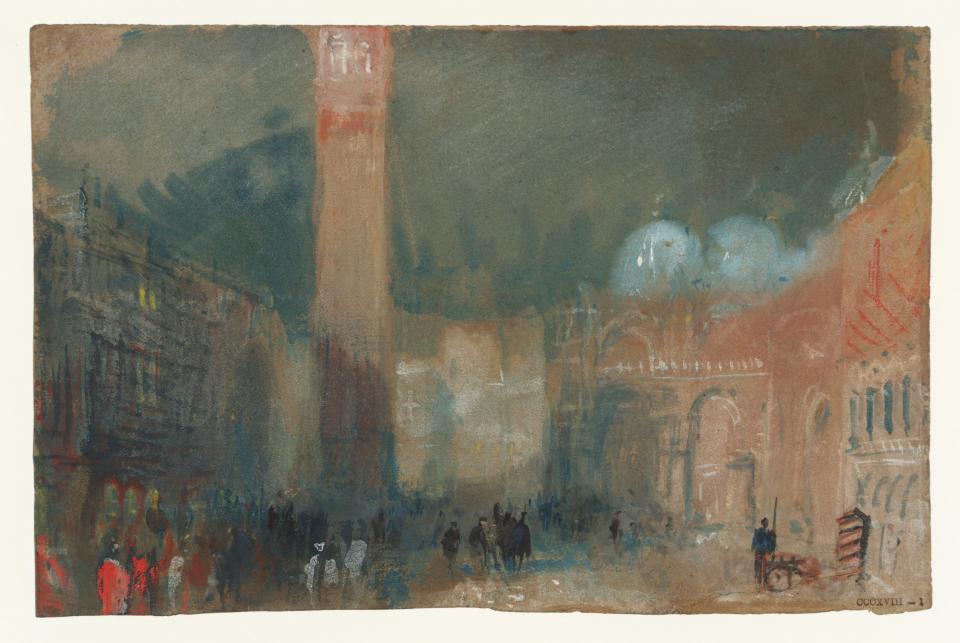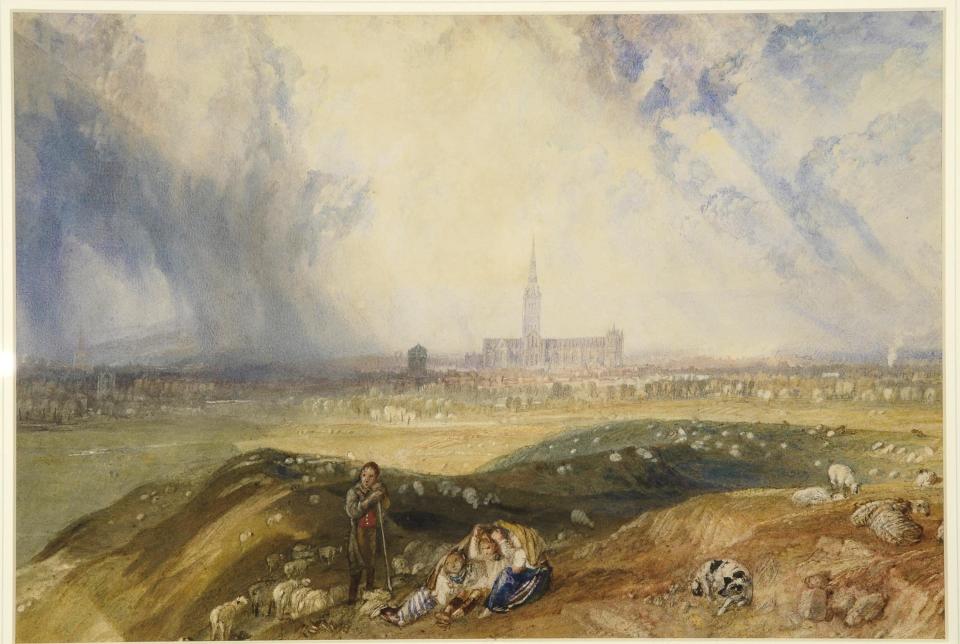Turner and the art of travel

I won’t milk the irony, but next year marks the bicentenary of the first cross-Channel ferry service between Britain and France. I was reminded of this while walking round a new exhibition of JMW Turner’s paintings at Tate Britain this week. In the middle ground of his view of the white cliffs of Dover, I noticed a paddle steamer ploughing through the choppy waves.
Painted in 1825, the little watercolour, which was made for a series of prints, is a romanticised prospect, not a documentary one. Dover Castle towers above the cliffs in exaggerated, picturesque fashion and the steamer, its decks crowded with passengers, seems impossibly fragile among the choppy surf outside the harbour entrance.
But even if he chose not to depict it literally, Turner surely intended the steamer to represent the earliest cross-Channel ferry, an 80ft steam packet named the Rob Roy. She had started the first regular service between England and France just four years earlier and her schedule had transformed connections for travellers to the continent, turning an unpredictable day’s sail into a regular three-hour crossing.

The steamer and the cross-Channel service reflect the main theme of the Tate exhibition – Turner’s “modernity” – and many of the paintings and prints on show depict the impact of the industrial revolution on transport. But although one of his most famous, Rain, Steam and Speed (it’s on loan from the National Gallery for this exhibition), captures the excitement and drama of the new Great Western Railway in the 1840s, most of his work came before the great railway mania. In the early part of his career, it was not trains, but steamships like the Rob Roy which were were becoming a common sight on the Thames and the south coast. They were shrinking distances and opening up new horizons by making travel more reliable and more affordable.
Turner himself was one of the first to take advantage of these new opportunities. He became an inveterate traveller, and although his wanderlust was hampered at first by the chaos of the Napoleonic wars, his passion for continental travel was fired in 1802, when the short-lived Peace of Amiens allowed him to visit France and Switzerland. He travelled deep into the Alps, sketching and painting as he went, and his depiction of the Devil’s Bridge – which spans the precipitous Schöllenen Gorge and gives access to the St Gotthard Pass – is one of the most powerful and dramatic paintings in the exhibition.

The pass was one of the key routes for travellers from northern Europe into Italy, and the bridge was not only the most famous moment in the trans-Alpine journey but had been the scene of fighting between Austro-Russian and French troops only a year earlier. Turner relishes the drama of the swirling mists, the torrent thundering between the vertiginous cliffs, and intensifies the theatricality of the painting by including the lonely figure of a man, outlined against the spray rising from the cascades far below, taking his first nervous steps on the crossing.
There is no doubt – as in his view of Dover – that Turner was indulging in some poetic licence here. Looking at the same scene today, we can see how he heightened the drop and exaggerated the drama. True, we can’t make an exact comparison – the bridge Turner painted was replaced in 1830 and the old one collapsed in 1888. However, the shape and design of the later version were similar and it is still one of the sights of the St Gotthard Pass even today.
He certainly knew that adapting landscapes to chime with contemporary taste was good for business, especially once Europe was at peace again. A new breed of wealthy, middle-class sightseers provided a lucrative commercial opportunity. They were hungry for paintings and prints of popular beauty spots which Turner would market, singly or in sets, either as souvenirs or as inspiration for future travels which were also to take him through the Low Countries, the Rhineland, and many parts of Italy.
Venice was a particular favourite, and three of his views are on show in the exhibition, including two by moonlight. In a way he was emulating on the success that Canaletto had enjoyed half a century earlier selling views of Venice to British aristocrats on a Grand Tour of Italy. But Turner cast his net far wider than his Italian predecessor, and it was the Alps which seem to have held the most powerful draw for him. He made several journeys there in 1830s and 1840s and some of his most famous images were his series of watercolours of the Rigi Mountain overlooking Lake Lucerne, which he sketched and painted more than 30 times.

Indeed he was partly responsible for popularising this part of the mountains as a holiday destination. The highlight of Thomas Cook’s first package tour to Switzerland in 1863 was an ascent of the Rigi to watch the sunrise. The mountain was soon a fashionable fixture on the itineraries of early British tourists taking their summer holidays on the continent and the appeal was cemented after Queen Victoria spent a month in Lucerne in the summer of 1868. She produced her own watercolours and even made her way up to the summit, sitting side-saddle on her favourite pony.
Turner also enjoyed some of the earliest river cruises, which, as today, were rapidly growing in popularity. He booked voyages on steamers down both the Loire and the Seine, specifically to depict the highlights in series of prints. They were marketed as Turner’s Annual Tour, which – ever the astute businessman – he would release just in time for Christmas.
Turner’s modus operandi was to spend his summers travelling and sketching and then work up his paintings and prints in his London studio in the winter. And when he wasn’t visiting Europe, he would tour Britain instead. Between 1827 and 1838, he produced his Picturesque Views of the Antiquities of England and Wales, which failed as a commercial venture, but was an important part of his artistic development. Among the landscapes on show at Tate are an early sketch of Llanstephan Castle by moonlight, views of Edinburgh and across the River Tees at Wycliffe, and, one of my favourites, his view of Salisbury Cathedral from Old Sarum.

But it would obviously be wrong to think of Turner as simply a crowd-pleasing painter of tourist highlights. While he had an eye for the market, his landscapes are far from sentimentalised. In fact, he peppered his paintings with political references and social critiques. One of those moonlit scenes in Venice includes the silhouette of an Austrian soldier on guard, a reminder that the city was under foreign occupation. He depicts the glow of industrial kilns and furnaces in the foreground at Llanstephan. And no matter how calm and idyllic the view, any reference to Old Sarum was a provocative reference to contemporary political corruption and manipulation. In the run up to the Great Reform Bill, this was one of the most famous of the rotten boroughs which campaigners were denouncing. It an electorate of just seven, it returned two MPs to Westminster.
Turner’s fascination with the horrors of the war, which for so long frustrated his travels, is also palpable. His town views and landscapes often subtly include figures of wounded soldiers or beggars – signs of the devastating social impact of 20 years of conflict. And just two years after it was all over, in 1817, Turner went to visit Waterloo himself. He was, I suppose, one of the very first battlefield tourists, and he employed a veteran to give him a proper guided tour of the field.
What Turner produced as a result of his visit was not a patriotic account of a great national triumph, but an apocalyptic scene of devastation. He depicts a field of smoke and fire, of darkness splintered by a shell blast, with the foreground piled high with the bodies of the dead and wounded. It is a painting about horror and grief, and, I would argue, testament to the power of travel – how being somewhere can change the way you understand and feel. Turner knew this, and used it to inspire his art. Before he painted Waterloo, he had depicted another great victory over Napoleon – Trafalgar – in a painting made in 1806, less than a year after the battle. Part of his preparation was to visit HMS Victory, which had docked in Sheerness for repairs, and make sketches of the battle-scarred warship.

Also at the heart of Turner’s landscape painting is a fascination with technological progress. Just as the view of Dover includes a cross-Channel ferry, so other scenes depicted details of the new bridges, canals and industrial developments which were transforming contemporary life. The serene account of Chichester Canal, like that of Old Sarum, included a cathedral spire in the far distance. But it also documented what was intended as a new infrastructure project – the canals and waterways linking London to the south coast. Though, as it turned out, it was soon to be made redundant by the development of the railways.
Walking around the exhibition, I also found myself thinking about a fundamental contrast between Turner and his exact contemporary, Constable. Each was a radical artist for their time and each has a claim to be considered our foremost national painter. But their approaches to travel could hardly have been more different.
Constable’s gentle cloud-puffed skies, and his calm evocations of the dips and hollows of the Suffolk-Essex border, have cemented an idea of the English countryside in our minds. They are powerful reflections on what was most familiar to him – a world where life went on in steady, unchanging rhythms. But while Constable did travel a little, he didn’t enjoy it much. He was an artist who felt most comfortable when he stayed at home: “I should paint my own places best,” he once wrote.
Turner, on the other hand, was energised by change and novelty, and driven by wanderlust. First and foremost, he was a social commentator who documented his changing times. But his facility for capturing a sense of place was also an inspiration in an era when travel was quickly becoming affordable for more people than just the aristocracy.
In the days before photography, it was Turner’s imagery, perhaps above that of any other painter, which helped his contemporaries visualise the wonders of the world. For those of us looking at them 200 years later, they are a reminder of the earliest days of popular tourism and the central role of technology in transforming our ability to get out and see those wonders for ourselves.
Turner’s Modern World opened at Tate Britain today and continues until March 7 (currently booking until December 31). All tickets (£22) are timed and must be booked before visiting (tate.org.uk).

